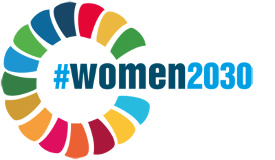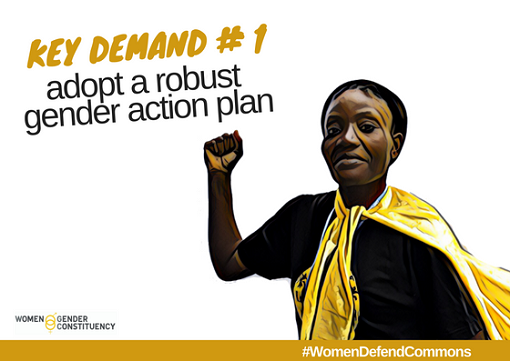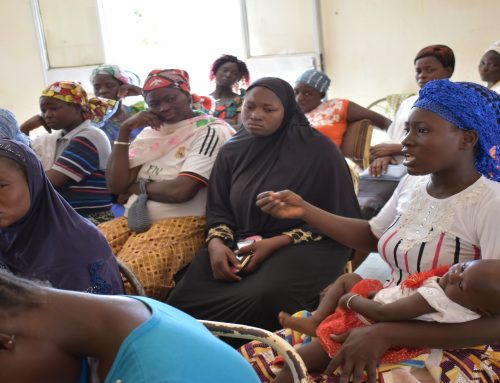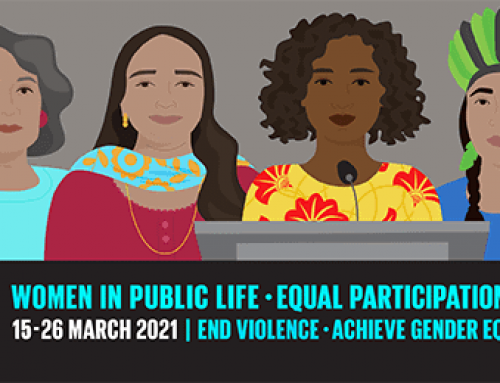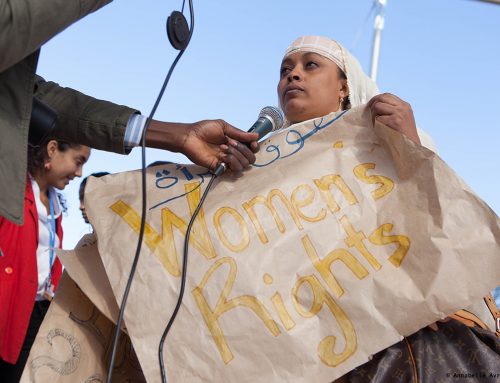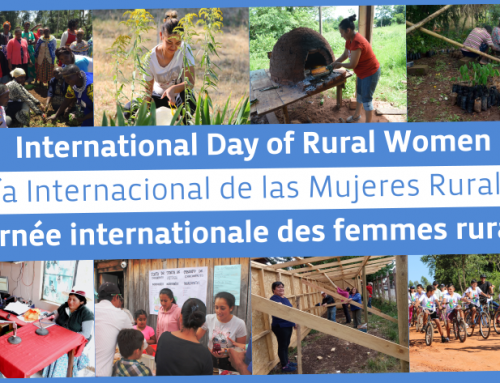Press Release
COP23, Bonn, Germany
15 November 2017
On Tuesday November 14, 2017 the first ever Gender Action Plan to the UNFCCC was adopted at COP23. Its overall goal is to support and enhance the implementation of the gender-related decisions and mandates so far adopted in the UNFCCC process through a set of specific activities to be conducted within the next 2 years.
Kalyani Raj, All India Women’s Conference
“The adoption of the Gender Action Plan (GAP) is a positive step forward. It goes to reassure some of our work at the national level particularly relating to gender integration into climate change policies and related schemes. We would be happy to work with our government at the implementation level and hope to close bigger gaps impeding gender inequality with the GAP.”
Bridget Burns, co-focal point of the Women and Gender Constituency and co-director of the Women’s Environment and Development Organisation (WEDO)
“We are well beyond the time for real action on gender-just climate policies.The Gender Action Plan (GAP) serves as an important accelerator in advancing multiple mandates for gender equality that exist under the UNFCCC. But, the test will be in the implementation. We will be holding governments accountable, both developed countries in putting serious financing into gender-responsive policy development as well as all countries in fulfilling human rights via their climate plans. For a truly gender-just climate change framework, we must continue to demand climate justice from the entire process.”
Shradha Shreejaya, Asia-Pacific Forum on Women, Law and Development (APWLD)
“The proceedings on GAP have been reassuring. Keeping in mind however the urgency of the climate crisis, especially in Asia-Pacific and Africa, we need strengthened action and solidarity from developed countries in terms of committing to finance GAP as well as Loss and Damages, something that’s still amiss from COP 23 decisions.”
Dinda Yura, Solidaritas Perempuan, Indonesia
“We now have Gender Action Plan, as one step of the milestones for gender equality and women’s empowerment through inclusiveness of women as well as gender sensitive and responsive policies and actions in all elements of mitigation, adaptation, capacity building, technology transfer, and finance. What we need to think and do further in the implementation is how to use GAP and mainstreaming gender justice principles and be integrated in policies and climate actions, in particularly at national and local level, to ensure there is no climate policies and actions that violate women’s rights and the rights of women can be protected in the midst of climate crisis.”
Gotelind Alber, board member of GenderCC – Women for Climate Justice and co-founder of the Women and Gender Constituency
“The Gender Action Plan is a milestone in our longstanding efforts to integrate gender into the international climate process. If properly implemented, resourced and monitored it bears the potential to move us closer to achieving women’s full, equal and meaningful participation in the UNFCCC process and the development and implementation of gender-responsive and human rights based climate policies in all thematic areas of the process as well as on national and sub-national levels.”
Priscilla M Achakpa, Director of Women’s Environmental Programme and gender expert on the Nigerian Delegation
“Now that the GAP has been adopted, it is time to work collectively from the regional to the global level while ensuring that resources and made available for the full implementation of the GAP. We cannot afford to fail, grassroots, indigenous population and communities must be fully integrated in the GAP.”
Anne Barre, Women Engage for a Common Future (WECF) International
“The GAP is essential because there is still so much to do to bridge the “gender gap” and have more efficient climate policies! For example in climate finance, according to the OECD 2017 report, less than 5% of climate funds have gender as a main objective. Thus women’s priorities are being totally neglected, and women have no direct access to climate funding. And yet, many innovative solutions on the ground exist today that should be upscaled with direct access to the Green Climate Fund. In turning the patriarchal system upside down, we will be able to reach the goal of the Paris Agreement.”
Marta Benavides, social movements, El Salvador, Latin America
“Women have been at the forefront of human development, for women caring for the planet and the well being of nature and humans in their families and communities. The Gender Action Plan is an affirmation of that. As it is the affirmation of the indigenous peoples path. It was a historical debt for the climate process. We now expect to start working for the essentials of the climate process: to work effectively and urgently to keep global warming under 1.5°C and to move effectively on all needed levels towards a just transition and to ensure that really and for good No One Is Left Behind.”
WHO
The Women and Gender Constituency to the UNFCCC
WHEN
Tuesday, 14 November, 2017
WHERE
COP23 climate negotiations in Bonn, Germany
WHY
Climate change is one of the most daunting global challenges of our time. As changing temperatures, weather patterns, and ecological systems threaten communities all over the world, the effects will be felt differently between the global North and South, various social classes, and between men and women. Just as any disaster can exacerbate existing social differences, climate change can be expected to worsen the distinction between men, women, and gender-nonconforming individuals in terms of opportunity, safety, and general wellbeing. In addition to the looming threat posed by climate change, gender distinctions in relation to environmental issues can already be observed. According to the Women’s Environmental Development Organization (http://wedo.org,) only 12% of federal environment ministries worldwide are headed by women, as of 2015. Women on average make up 43% of the agricultural labor force in developing countries, and around 50% in sub-Saharan Africa. As of 2010, only 15% of land in sub-Saharan Africa is owned by women. Females are more likely to be killed by natural disasters and/or are systematically killed more often than males. In Malawi, gender inequalities in agriculture cost USD $100 million. At the current rate of increase, gender parity in negotiations will only be reached by 2040.
The Gender Action Plan represents a landmark opportunity to improve the quality of life for women worldwide, as well as ensure their equal representation in climate policy and planning.
ABOUT
The Women and Gender Constituency (WGC) is one of the nine stakeholder groups of the United Nations Framework Convention on Climate Change (UNFCCC). Established in 2009, the WGC now consists of 27 women’s and environmental civil society organizations, who are working to ensure that women’s voices and their rights are embedded in all processes and results of the UNFCCC framework, for a sustainable and just future, so that gender equality and women’s human rights are central to the ongoing discussions. As the WGC represents the voices of hundreds and thousands of people across the globe, members of the Constituency are present at each UNFCCC meeting and intersessional alongside the UNFCCC Secretariat, governments, civil society observers and other stakeholders to ensure that women’s rights and gender justice are core elements of the UNFCCC. In this action the constituency is joined by other stakeholders committed to advancing women’s human rights, peace and climate justice.
MORE RESOURCES

